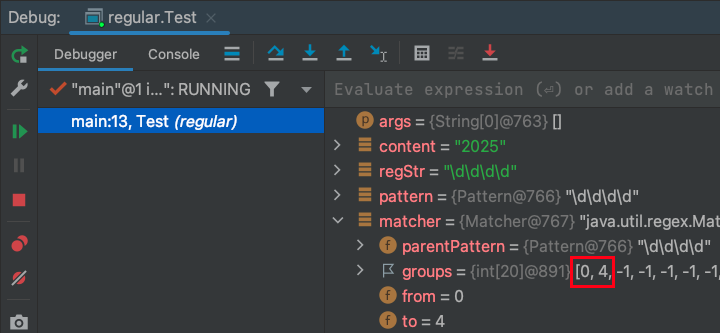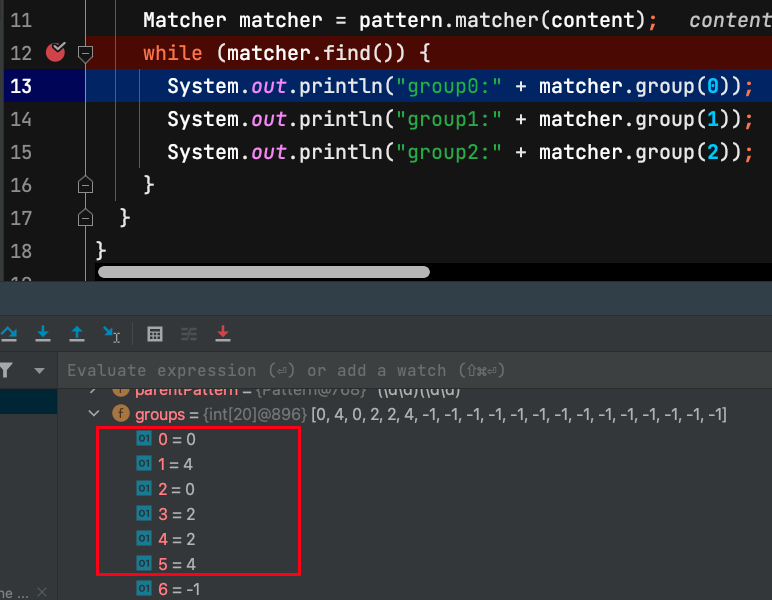規則表示式
套件
import java.util.regex.Pattern;
跳脫字元
以下這些跳脫字元,使用時,前面要加上2個右斜\\,注意!不是一個。
.*+()$/\?[]{}^
在content的內容中,比對跳脫字元.。
1
2
3
4
5
6
7
String content = "abcdef.hijkl.";
String regStr = "\\.";
Pattern pattern = Pattern.compile(regStr);
Matcher matcher = pattern.matcher(content);
while (matcher.find()) {
System.out.println(matcher.group(0));
}
.
.
[]比對一個字母或數字
[]或
被括號[]包住的字母或數字,假設是[abc123],這個規則的意思是,找尋是否有a或b或c或1或2或3,任一個字母。
aaabbccdef.hi3214516278jkl.
1
2
3
4
5
6
7
String content = "aaabbccdef.hi3214516278jkl.";
String regStr = "[abc123]";
Pattern pattern = Pattern.compile(regStr);
Matcher matcher = pattern.matcher(content);
while (matcher.find()) {
System.out.println(matcher.group(0));
}
a
a
a
b
b
c
c
3
2
1
1
2
[^]相反
被括號[]包住的字母或數字,假設是[^abc123],這個規則的意思是,找尋「不是」a或b或c或1或2或3,任一個字母。
aaabbccdef.hi3214516278jkl.
1
2
3
4
5
6
7
String content = "aaabbccdef.hi3214516278jkl.";
String regStr = "[^abc123]";
Pattern pattern = Pattern.compile(regStr);
Matcher matcher = pattern.matcher(content);
while (matcher.find()) {
System.out.println(matcher.group(0));
}
d
e
f
.
h
i
4
5
6
7
8
j
k
l
.
- 範圍
-比對字母或數字的範圍。
[d-h1-3]比對字母d到h,數字1到3,任一個字元。
1
2
3
4
5
6
7
String content = "aaabbccdef.hi3214516278jkl.";
String regStr = "[d-h1-3]";
Pattern pattern = Pattern.compile(regStr);
Matcher matcher = pattern.matcher(content);
while (matcher.find()) {
System.out.println(matcher.group(0));
}
d
e
f
h
3
2
1
1
2
表格說明
| []或 | 說明 |
|---|---|
[abc] |
a或b或c,任一個字元。 |
[^abc] |
「不是」a或b或c,其它任一個字元。 |
[a-zA-Z] |
比對小寫大寫英文字母,任一個字元。 |
[0-9] |
比對數字,任一個字元。 |
[^0-9] |
比對「不是」數字,任一個字元。 |
比對字串
比對「abc」字串,「三個一起」比對,跟前面的[]不同,[]方括號是比對裡面中任意一個字母或數字,而這裡是比對「abc」字串。
1
2
3
4
5
6
7
String content = "abcdefghijklmabcn";
String regStr = "abc";
Pattern pattern = Pattern.compile(regStr);
Matcher matcher = pattern.matcher(content);
while (matcher.find()) {
System.out.println(matcher.group(0));
}
abc
abc
或|
比對abc字串「或」ijk字串,比對二個字串,注意!這裡沒有方括號[]。
1
2
3
4
5
6
7
String content = "abcdefghijklmabcn";
String regStr = "abc|ijk";
Pattern pattern = Pattern.compile(regStr);
Matcher matcher = pattern.matcher(content);
while (matcher.find()) {
System.out.println(matcher.group(0));
}
\\d \\w
\\d \\D
\\d比對0-9的數字。
\\D比對「非」0-9的數字
1
2
3
4
5
6
7
String content = "abcde012fgh34ijklmabcn";
String regStr = "\\d";
Pattern pattern = Pattern.compile(regStr);
Matcher matcher = pattern.matcher(content);
while (matcher.find()) {
System.out.println(matcher.group(0));
}
0
1
2
3
4
\\w \\W
\\w比對任一英文字母、數字、底線。
\\W比對任一「非」英文字母、數字、底線。
跳脫字元,不屬於w。
1
2
3
4
5
6
7
String content = "abc@$_ABC_012@~";
String regStr = "\\w";
Pattern pattern = Pattern.compile(regStr);
Matcher matcher = pattern.matcher(content);
while (matcher.find()) {
System.out.println(matcher.group(0));
}
a
b
c
_
A
B
C
_
0
1
2
比對空白
1
2
3
4
5
6
7
String content = "abc abc abc";
String regStr = "\\s";
Pattern pattern = Pattern.compile(regStr);
Matcher matcher = pattern.matcher(content);
while (matcher.find()) {
System.out.println(matcher.group(0));
}
.比對任一個字元
比對任一個不是\n之外的所有字元。
1
2
3
4
5
6
7
String content = "abc\nabc";
String regStr = ".";
Pattern pattern = Pattern.compile(regStr);
Matcher matcher = pattern.matcher(content);
while (matcher.find()) {
System.out.println(matcher.group(0));
}
a
b
c
a
b
c
表格說明
| 字元 | 說明 |
|---|---|
| . | 比對任一個不是\n之外的所有字元。 |
\\d |
比對任一個數字,[0-9] |
\\D |
比對任一個「非」數字,[^0-9] |
\\w |
比對任一個英文字母、數字、底線,[a-zA-Z0-9_] |
\\W |
比對任一個「非」英文字母、數字、底線,[^a-zA-Z0-9_] |
\\s |
比對任一個空白 |
\\S |
比對任一個「非」空白,[^\s] |
重覆次數
+ 重覆至少1次至n次
以下範例比對a字母至少1次至n次
1
2
3
4
5
6
7
String content = "abcaabcaaabcaaaa";
String regStr = "a+";
Pattern pattern = Pattern.compile(regStr);
Matcher matcher = pattern.matcher(content);
while (matcher.find()) {
System.out.println("找到:" + matcher.group(0));
}
找到:a
找到:aa
找到:aaa
找到:aaaa
* 重覆0次至n次
比對a為開頭的字母(重覆至少1次至n次),後面可以有b也可以沒有b(重覆至少0次至n次)。
1
2
3
4
5
6
7
String content = "abaabbcac";
String regStr = "a+b*";
Pattern pattern = Pattern.compile(regStr);
Matcher matcher = pattern.matcher(content);
while (matcher.find()) {
System.out.println("找到:" + matcher.group(0));
}
找到:ab
找到:aabb
找到:a
? 重覆0次至1次
比對a為開頭的字母(重覆至少1次至n次),後面只能有「一個b」也可以沒有b(重覆至少0次至1次)。
1
2
3
4
5
6
7
String content = "abaabbcac";
String regStr = "a+b?";
Pattern pattern = Pattern.compile(regStr);
Matcher matcher = pattern.matcher(content);
while (matcher.find()) {
System.out.println("找到:" + matcher.group(0));
}
找到:ab
找到:aab
找到:a
比對a開頭,後面只能有「一個1」也可以沒有1。
1
2
3
4
5
6
7
String content = "a11111111aaa";
String regStr = "a1?";
Pattern pattern = Pattern.compile(regStr);
Matcher matcher = pattern.matcher(content);
while (matcher.find()) {
System.out.println("找到:" + matcher.group(0));
}
找到:a1
找到:a
找到:a
找到:a
{n} 自訂重覆次數
以下程式碼,比對b重覆2次,等同bb
其它還有{n,m},自訂重覆至少n次至m次。
{n,},自訂重覆至少n次至無限次。
1
2
3
4
5
6
7
String content = "abaabbcacbbb";
String regStr = "b{2}";
Pattern pattern = Pattern.compile(regStr);
Matcher matcher = pattern.matcher(content);
while (matcher.find()) {
System.out.println("找到:" + matcher.group(0));
}
找到:bb
找到:bb
表格說明
| 次數 | 說明 |
|---|---|
| + | 重覆至少1次至n次 |
| * | 重覆0次至n次 |
| ? | 重覆0次至1次 |
| {n} | 自訂重覆次數 |
| {n,} | 自訂重覆至少n次至無限次 |
| {n,m} | 自訂重覆至少n次至m次 |
組合與次數
{n}
之前[]代表「或」的意思,此處搭配次數,代表組合的意思。
[ab]{2}代表由ab2個字母,任意組合成字串,字串長度為2個字母,可以是aa、ab、bb、ba。
1
2
3
4
5
6
7
String content = "abaabbcacbbba";
String regStr = "[ab]{2}";
Pattern pattern = Pattern.compile(regStr);
Matcher matcher = pattern.matcher(content);
while (matcher.find()) {
System.out.println("找到:" + matcher.group(0));
}
找到:ab
找到:aa
找到:bb
找到:bb
找到:ba
{n,m}
比對abcd四個字母,任意組合成字串,字串長度至少2至3。
1
2
3
4
5
6
7
String content = "abfagbbcacebbba";
String regStr = "[abcd]{2,3}";
Pattern pattern = Pattern.compile(regStr);
Matcher matcher = pattern.matcher(content);
while (matcher.find()) {
System.out.println("找到:" + matcher.group(0));
}
找到:ab
找到:bbc
找到:ac
找到:bbb
\\d \\w與重覆次數
\\d比對任一個數字,等同[0-9]。
\\d搭配次數,代表至少重覆幾次。
以下程式碼比對數字0-9,0-9任意數字重覆次數為最少為2次,最多為3次。
1
2
3
4
5
6
7
String content = "ab01fag2356bbc55555acebbba";
String regStr = "\\d{2,3}";
Pattern pattern = Pattern.compile(regStr);
Matcher matcher = pattern.matcher(content);
while (matcher.find()) {
System.out.println("找到:" + matcher.group(0));
}
找到:01
找到:235
找到:555
找到:55
貪婪比對
優先比對次數多的。
以下程式碼,有6個a,結果不是aaa、aaa,而是只比對到aaaa,4個a。
1
2
3
4
5
6
7
String content = "aaaaaa";
String regStr = "a{3,4}";
Pattern pattern = Pattern.compile(regStr);
Matcher matcher = pattern.matcher(content);
while (matcher.find()) {
System.out.println("找到:" + matcher.group(0));
}
找到:aaaa
以下程式碼,有8個1,結果不是1111、1111,而是只比對到11111,5個1。
優先比對次數多的。
1
2
3
4
5
6
7
String content = "11111111";
String regStr = "1{4,5}";
Pattern pattern = Pattern.compile(regStr);
Matcher matcher = pattern.matcher(content);
while (matcher.find()) {
System.out.println("找到:" + matcher.group(0));
}
找到:11111
優先比對次數多的。以下程式碼使用+,1至多,盡可能比對最多數字。
1
2
3
4
5
6
7
String content = "11111111";
String regStr = "1+";
Pattern pattern = Pattern.compile(regStr);
Matcher matcher = pattern.matcher(content);
while (matcher.find()) {
System.out.println("找到:" + matcher.group(0));
}
找到:11111111
位置字元
| 字元 | 說明 |
| ^ | 開頭 |
| $ | 結尾 |
\\b |
空格前的「結尾」或字串「結尾」 |
\\B |
空格前的「開頭」或字串「開頭」 |
^開頭
^[abc][0-9]+字串只能以「一個」a數字、b數字、c數字開頭。若是aa11,也不行,因為有2個a。
1
2
3
4
5
6
7
String content = "a11bb2335ccc1";
String regStr = "^[abc][0-9]+";
Pattern pattern = Pattern.compile(regStr);
Matcher matcher = pattern.matcher(content);
while (matcher.find()) {
System.out.println("找到:" + matcher.group(0));
}
a11
$結尾
字串只能以「一個」a數字、b數字、c數字開頭,一個跳脫字元-結尾,跳脫字元在java中要用二個右斜線\\跳脫字元。
1
2
3
4
5
6
7
String content = "a1122-";
String regStr = "^[abc][0-9]+\\-$";
Pattern pattern = Pattern.compile(regStr);
Matcher matcher = pattern.matcher(content);
while (matcher.find()) {
System.out.println("找到:" + matcher.group(0));
}
找到:a1122-
空格前結尾 字串結尾
以下程式碼,abc是比對條件。
空格前結尾,意思是「ingabc 」字串,空格之前,結尾是不是「abc」三個字?
字串結尾,意思是「abcingabc」字串,字串的結尾是不是「abc」三個字?
ingabc ingabc abc
1
2
3
4
5
6
7
String content = "ingabc ingabc abc";
String regStr = "abc\\b";
Pattern pattern = Pattern.compile(regStr);
Matcher matcher = pattern.matcher(content);
while (matcher.find()) {
System.out.println("找到:" + matcher.group(0));
}
找到:abc
找到:abc
找到:abc
空格後開頭 字串開頭
以下程式碼,abc是比對條件。
空格後開頭,意思是「 abcing」字串,空格之後,開頭是不是「abc」三個字?
字串開頭,意思是「abcing」字串,字串的開頭是不是「abc」三個字?
abcing abcing abc
1
2
3
4
5
6
7
String content = "abcing abcing abc";
String regStr = "abc\\B";
Pattern pattern = Pattern.compile(regStr);
Matcher matcher = pattern.matcher(content);
while (matcher.find()) {
System.out.println("找到:" + matcher.group(0));
}
找到:abc
找到:abc
分組
group(0)
group(0)記錄的是比對到字串的開始索引與結束索引。
以下程式碼,規則是4個數字,相等於\\d{4}或[0-9]{4}。
1
2
3
4
5
6
7
String content = "2025";
String regStr = "\\d\\d\\d\\d";
Pattern pattern = Pattern.compile(regStr);
Matcher matcher = pattern.matcher(content);
while (matcher.find()) {
System.out.println("group0:" + matcher.group(0));
}
group0:2025
1.先使用中斷點,請像下圖中一樣,設定中斷點,並且執行debug。

2.把groups打開,發現全部都是-1。

3.按「step over」,F8,逐步執行。
發現groups陣列索引[0]為0,是比對到字串2025的開始索引。
發現groups陣列索引[1]為4,是比對到字串2025的結束索引。

matcher.group()原始碼
1
2
3
4
5
6
7
public String group(int group) {
checkMatch();
checkGroup(group);
if ((groups[group*2] == -1) || (groups[group*2+1] == -1))
return null;
return getSubSequence(groups[group * 2], groups[group * 2 + 1]).toString();
}
以下的程式碼groups[group * 2]代表開始索引,groups[group * 2 + 1]代表結束索引,把group = 0代入,發現會取得索引groups[0]與groups[1]的字串。
1
getSubSequence(groups[group * 2], groups[group * 2 + 1])
group(1)與group(2)
使用圓括號()進行分組,分組序號是由1開始,注意!不是0開始。
1 2
(\d\d)(\d\d)
對以下程式碼,while (matcher.find())加上中斷點,跟之前步驟一樣。
1
2
3
4
5
6
7
8
9
String content = "2025";
String regStr = "(\\d\\d)(\\d\\d)";
Pattern pattern = Pattern.compile(regStr);
Matcher matcher = pattern.matcher(content);
while (matcher.find()) {
System.out.println("group0:" + matcher.group(0));
System.out.println("group1:" + matcher.group(1));
System.out.println("group2:" + matcher.group(2));
}
group0:2025
group1:20
group2:25

group0:
groups[0] = 0,是比對到字串2025的開始索引。
groups[1] = 4,是比對到字串2025的結束索引。
group1:
groups[2] = 0,是比對到字串2025的開始索引。
groups[3] = 2,是比對到字串2025的結束索引。
group2:
groups[4] = 2,是比對到字串2025的開始索引。
groups[5] = 4,是比對到字串2025的結束索引。
不是分組
以下的()圓括號不是分組,不能使用matcher.group(1)。
(?:規則)
(?:規則)跟「或|」一樣。
字串win98,winxp,win2000
比對開頭為win,後面可以是98或xp的字串,等同win98|winxp。
1
2
3
4
5
6
7
String content = "win98,winxp,win2000";
String regStr = "win(?:98|xp)";
Pattern pattern = Pattern.compile(regStr);
Matcher matcher = pattern.matcher(content);
while (matcher.find()) {
System.out.println("找到" + matcher.group(0));
}
找到win98
找到winxp
(?=規則)
win(?=98|xp)
字串win98,winxp,win2000
比對開頭為win,後面是98或xp中的「win」。
1
2
3
4
5
6
7
String content = "win98,winxp,win2000";
String regStr = "win(?=98|xp)";
Pattern pattern = Pattern.compile(regStr);
Matcher matcher = pattern.matcher(content);
while (matcher.find()) {
System.out.println("找到" + matcher.group(0));
}
找到win
找到win
(?!規則)
win(?!98|xp)
!代表相反,也就是「不是」的意思。
字串win98,winxp,win2000
比對開頭為win,但後面「不是」98或xp中的「win」。
1
2
3
4
5
6
7
String content = "win98,winxp,win2000";
String regStr = "win(?!98|xp)";
Pattern pattern = Pattern.compile(regStr);
Matcher matcher = pattern.matcher(content);
while (matcher.find()) {
System.out.println("找到" + matcher.group(0));
}
找到win